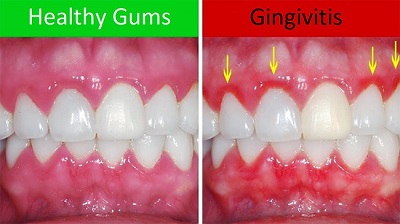Oral infections - Salivary gland infection, Periodontitis, Gingivitis, Mandibular abscess
Introduction to Oral infections
Oral infection in humans can manifest as:
Gingivitis
Anaerobic infection - Periodontitis
Salivary gland infection
Mandibular abscess
Clinical manifestations of oral infection
The clinical manifestations of oral infections include:
Gingivitis
Gingivitis is a common and mild form of periodontal disease characterized by inflammation of the gums. The gum becomes swollen, dark red, and tender. Bidding occurs during brushing. The most common cause of gingivitis is the accumulation of plaque in teeth.
Major risk factors
Poor oral hygiene
Smoking and chewing tobacco
Hormonal changes,
Malnourishment (caused by Streptococcus mutans, Actinobacillus)

Fig: Gingivitis (Source: Carson and Carson, DDS)
Anaerobic infection
Periodontitis
Periodontitis results as a complication of gingivitis. During periodontitis collagen attachment of the gum to the teeth is lost. This forms a pocket in which plaque gets deposited. The plaque hardens to form tartar (calculus) in which bacteria gets deposited. Severe inflammation occurs characterized by bleeding gums, pus formation between gums and teeth, bad breath, and painful chewing.
Etiological agents
The commonly associated bacteria causing periodontitis are:
Prophyromonas gingivalis
Pervotella intermedia
Actinobacillus actinomycetocomitans
Fusobacterium nucleatum
Pervotella melanogenica
Pervotella oralis
* The tissues in, around, and supporting the tooth get infected and damaged.
Other etiological agents infecting periodontitis include:
Staphylococci
Eikenella corrodens
Streptococcus anginosus
Bacteroides fragilis
Peptostreptococcus
Veillonella
Fusobacterium
Actinomyces israelii
Salivary gland infection
Acute suppurative parotitis (inflammation of the salivary glands located under the cheek of the front and below the external ear) is seen in very ill patients, especially those who are dehydrated, malnourished, elderly, or recovering from surgery.
It is associated with painful, tender swelling of the parotid gland. Purulent drainage may be evident at the opening of the duct of the gland in the mouth.
Etiological agent
Staphylococcus aureus (major pathogen)
Enterobacteriaceae
oral anaerobes
Mycobacterium tuberculosis (frequent) - is involved in infection with the parotid gland in conjugation with pulmonary tuberculosis
Mandibular abscess
Mandibular abscess results in a complication of periodontitis. During an abscess, there is a localized collection of pus and usually, the origin of the abscess is bacterial in nature. The pus is generally accumulated in the soft, open, dead pulp of the teeth. It might also be associated with local tissue damage and necrosis. The mandibular abscess is treated with antibiotics and draining of pus.
The symptoms of mandibular abscess are:
Growing sharp throbbing pain
localized face swelling
lymphadenitis
headache